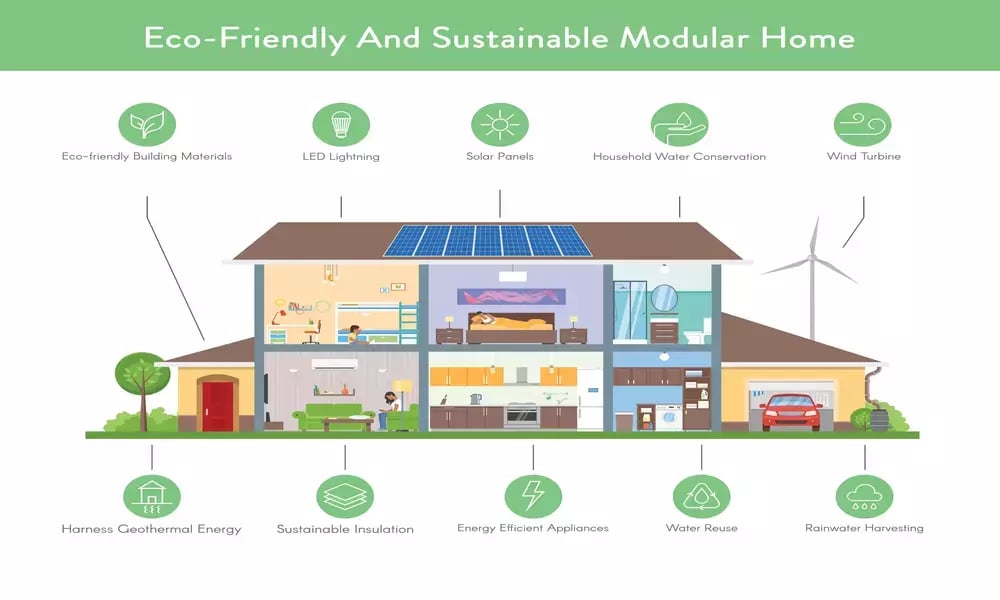Sustainable Living Spaces: Embracing Eco-Conscious Home Design

Introduction: Nurturing Sustainability Through Eco-Conscious Home Design
In the pursuit of a more sustainable and environmentally friendly lifestyle, adopting eco-conscious home design principles becomes pivotal. This article delves into the various facets of creating living spaces that not only reflect personal style but also minimize ecological impact.
Designing with Sustainable Materials: Foundations of Eco-Consciousness
At the core of eco-conscious home design lies the use of sustainable materials. From reclaimed wood and recycled metals to bamboo and cork, incorporating materials with minimal environmental impact sets the foundation for an eco-friendly living space. These materials not only contribute to resource conservation but also add unique textures and character to the design.
Energy-Efficient Architectural Elements: Illuminating the Green Path
Architectural elements that enhance energy efficiency play a crucial role in eco-conscious home design. Strategically placed windows for natural lighting, well-insulated walls, and energy-efficient appliances contribute to a reduced carbon footprint. Harnessing renewable energy sources like solar panels further amplifies the commitment to sustainable living.
Water Conservation Innovations: Flowing Towards Responsibility
In an eco-conscious home, water conservation is paramount. Implementing innovations such as low-flow fixtures, rainwater harvesting systems, and drought-resistant landscaping helps minimize water consumption. These thoughtful measures not only contribute to environmental conservation but also lead to long-term cost savings for homeowners.
Indoor Air Quality Considerations: Breathing Fresh Sustainability
Eco-conscious home design extends to indoor air quality, emphasizing the use of non-toxic and low-VOC (volatile organic compound) materials. Opting for eco-friendly paints, finishes, and furnishings ensures a healthier indoor environment, reducing the presence of harmful pollutants and promoting the well-being of the occupants.
Integrating Nature into Design: Biophilic Bliss
The concept of biophilic design involves incorporating nature into the home environment. This can be achieved through large windows framing outdoor views, indoor plants, and natural materials like stone and wood. Biophilic design not only enhances aesthetic appeal but also fosters a deeper connection with the natural world, promoting a sense of tranquility and well-being.
Smart Home Technology for Efficiency: The Tech-Savvy Green Home
Integrating smart home technology contributes to the efficiency of an eco-conscious home. Automated systems for lighting, heating, and cooling enable precise control, minimizing energy waste. Smart thermostats, energy-efficient appliances, and home automation platforms play a role in optimizing resource usage while providing modern conveniences.
Waste Reduction Strategies: From Design to Disposal
A key aspect of eco-conscious living is the reduction of waste throughout the home’s lifecycle. This involves considering the entire lifecycle of products, choosing durable materials, and implementing recycling systems. From construction waste reduction to mindful consumption habits, a holistic approach to waste management ensures a minimal environmental footprint.
Community and Local Engagement: Strengthening Eco-Consciousness
Eco-conscious home design extends beyond individual spaces to community and local engagement. Supporting local artisans, businesses, and sustainable initiatives contributes to a broader culture of environmental responsibility. Participating in local eco-friendly events and initiatives fosters a sense of community and collective commitment to a greener lifestyle.
Educating and Inspiring: Advocacy through Design
An essential element of eco-conscious home design is education and inspiration. Homeowners, architects, and designers can play a role in advocating for sustainable practices by sharing knowledge and showcasing successful eco-friendly projects. This advocacy contributes to a broader shift in the industry and encourages more individuals to embrace eco-conscious design principles.
Conclusion: A Sustainable Haven for the Future
In conclusion, embracing eco-conscious home design is not just a trend but a responsible choice for creating living spaces that align with environmental values. From sustainable materials and energy-efficient solutions to waste reduction strategies and community engagement, each element contributes to a sustainable haven for the present and future. Eco-conscious home design is a testament to the belief that responsible living can coexist with style and comfort.
Explore more about Eco-Conscious Home Design at jetdesignhome.my.id.






